Posted: July 30th, 2010 | Author: Nathan | Filed under: found sound objects, sound design

Brrrrwwwwaaaawwwrrrrrwwwaaar!
This might be harder to find at a thrift store than at an electronics or hobby store, but there are a large number of ultra-small toy helicopters on the market that can be had for not a lot of dosh. They’re flimsy. They don’t fly well. But they do scare the hell out of family pets, which instantly makes them entertaining, and they do make pretty cool sounds.
So, imagine this: You’re only one person with no assistants nearby. These helicopters, well, they fly erratically. How do you keep a mic trained on it to get a good recording? I solved this problem before by putting wireless mics on moving objects, but they’re far to heavy for something like this. Well, let’s just take advantage of the toy’s weak flying ability: Why not just hold the stupid thing while the rotors rotate? The rotors, however, rotate really quickly, and move a surprising amount of air. The body of the helicopter is so teensy that I couldn’t find a good mic position that blocked the air being moved around, which of course creates a lot of distortion and rumble.
Rather than futz around with a bulky windscreen and furry windjammer, I decided to just attach a contact microphone to the helicopter with gaffer’s tape. This worked reasonably well, especially after a quick equalization adjustment to overcome the somewhat dull midrange response of the mic itself. The sound that was transmitted through the high-density foam body was actually more interesting and full than the rotor’s sound in the free air, anyway. Besides the aforementioned EQ pass, this recording is unaltered. Recorded at 192kHz, this could provide all manner of mechanical effects if pitched down or processed further!
[soundcloud url=”http://soundcloud.com/noisejockey/toy-helicopter” params=”show_comments=true&auto_play=false&color=dd0000″ width=”100%” height=”81″ ]
[Contact microphone into Sound Devices 702 recorder]
Tags: digital audio, found object, helicopter, industrial, machine, sound design, sound effects, toy | 4 Comments »
Posted: July 27th, 2010 | Author: Nathan | Filed under: found sound objects, sound design
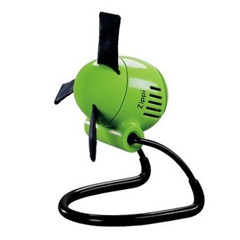
Meet Zippi: Suitable for propeller sounds of all kinds!
It’s been a long time since I’ve done a Thrift Store Sounds post, so let’s take a look at the nifty Vornado Zippi desktop fan!
It features soft cloth blades, a safety feature given the lack of a cage around the hub and its inevitable placement next to coffee mugs, iPads, and human fingers.
The motor’s not very powerful, and that’s really perfect for sound design. You can put your hand on the hub to slow it down. The soft blades let you stick all manner of wacky things in them without damaging the objects or the blades.
Today’s sound, then, is a short takes of sticking a ball-point pen into the fan blades. I think it’s great as a layering element for propeller sounds, be it a steampunk zeppelin or a toy/cartoon aircraft.
(If you want to hear more Thrift Store Sounds, be sure to check out recordings of a wicker basket and a shoe stretcher, or just use the Search too!)
[soundcloud url=”http://soundcloud.com/noisejockey/zippi” params=”show_comments=true&auto_play=false&color=dd0000″ width=”100%” height=”81″]
[OktavaMod MK-012 with cardioid cap, inside Rycote Baby Ball Gag windshield, into Sound Devices 702 recorder]
Tags: blade, digital audio, fan, found object, props, sound design, sound effects | 1 Comment »
Posted: July 22nd, 2010 | Author: Nathan | Filed under: field recording, found sound objects
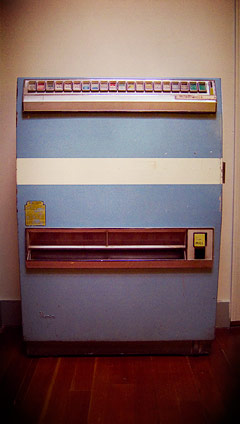
Mmm, so many tasty, carcinogenic choices.
Like over 100 other field recordists, I signed up for Tim Prebble’s crowdsourced special effects library of doors from around the world on his boutique effects label, Hiss and a Roar.
Unfortunately, due to extenuating circumstances, I had to bow out of the project, and a number of other side-projects. (Saying “no” is a powerful tool to help rein in your life from your own over-committal. Just do it early enough.)
However, one of the more interesting doors I did manage to record was the hinged front panel of an all-metal, 1970’s-era cigarette vending machine. This thing lives in my office, inherited from previous tenants. It’s too big to get rid of, and too odd and ironic to let go of, since none of us smoke. This object has been heard here before.
In honor of the awesome work everyone has done on this upcoming release, today’s sound is a fragment of my own aborted contribution, in the hopes that everyone will support Hiss and a Roar and pick up the collection when it’s released.
[soundcloud url=”http://soundcloud.com/noisejockey/cigmachinedoorslams” params=”show_comments=true&auto_play=false&color=dd0000″ width=”100%” height=”81″ ]
[Sennheiser MKH 50/30 mid-side stereo pair with into Sound Devices 702 recorder]
Tags: creak, digital audio, door, field recording, found object, machine, metal, sound design, sound effects | 8 Comments »
Posted: July 14th, 2010 | Author: Nathan | Filed under: field recording, found sound objects, sound design
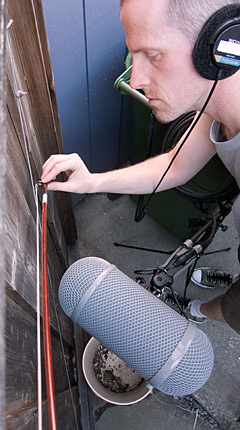
Noise Jockey: Taking the "E" out of "e-bow."
Almost exactly one year ago, I played a steel cable on a gate with an eBow , recorded with contact microphones. I decided to give it a go with a regular bow when I realized that this gate was basically a one-stringed guitar.
, recorded with contact microphones. I decided to give it a go with a regular bow when I realized that this gate was basically a one-stringed guitar.
Think about it: Wound metal string under tension, wooden resonator. That’s all a guitar really is. What a wooden gate lacks is thickness, like a guitar, but at more than a meter in width and height, that’s a broad-enough surface to send air molecules running for cover.
I had to rosin the hell out of the bow to make it tacky enough to grip this oversized “string.” I found that also spreading rosin on the wrapped steel cable was helpful. I tuned the cable, as much as one can, by adjusting a turnbuckle.
I recorded in mid-side stereo. Today’s sample features is comprised of one mono track totally dry, one mono track run through Michael Norris’ Spectral Blurring effect, one mono track pitch-shifted down by 1.5 octaves, and the one stereo track pitch-shifted down by three octaves. Recording at 192Hz helps for such tomfoolery.
I apologize to my neighbhors for the unholy racket that I’m sure they thought was a demonic violin 101 class.
[soundcloud url=”http://soundcloud.com/noisejockey/satans-violin-lesson” params=”show_comments=true&auto_play=false&color=dd0000″ width=”100%” height=”81″ ][Sennheiser MKH 50 and MKH 30 recorded as mid-side stereo into Sound Devices 702 recorder]
Tags: digital audio, drone, experimental, field recording, found object, industrial, metal, mid side, sennheiser, sound design, sound effects, violin bow | 5 Comments »
Posted: July 9th, 2010 | Author: Nathan | Filed under: field recording, gear, nature recording

Lookit that man out there. He's quite a dish.
One of the best reasons to spend a weekend with other sound recordists is a chance to try out new gear. A classic nature recording technique is the use of a microphone set in a parabolic dish.
The general public knows of parabolics mostly from seeing people use them on the sidelines of sporting events. In nature recording, they’re for capturing species-specific sounds rather than ambiences. This is because the microphones in parabolic dishes are mono, and have sound pushed into them by the dish itself. This creates a very narrow “beam” of listening. Perceptually, parabolics seem like they “zoom in” on sounds, but this is simply due to such microphones just attenuating all the sounds outside that narrow cone.
Parabolics are also interesting because the frequency response is directly tied to the size of the dish. For most song birds, this is fine. Besides, making and transporting a 17-meter-wide dish just to get a 20Hz-20kHz frequency response just seems silly. At that point, you’re practically into SETI territory! :-)
I got the chance to use one at the Nature Sounds Society Field Workshop. The unit you see in the photo above was the one used by the founder of the NSS, Paul Matzner, so I was holding a bit of history: Hand-made of fiberglass and aluminum, the NSS archives have lots of photos with Matzner holding this thing. Had I looked at the archives before heading into the field, I’d have gotten a way better handling technique. Holding it by its edges introduced horrendous amounts of handling noise.
Today’s sound is from this unit, recorded at 5:01am at Yuba Pass, off California Route 49. As far as I can tell, this is a chestnut-backed chickadee. You can tell, even in this recording, he’s got a lot of pals around (woodpeckers and sparrows at least).
[soundcloud url=”http://soundcloud.com/noisejockey/chestnut-backed-chickadee-yuba-pass-ca” params=”show_comments=true&auto_play=false&color=dd0000″ width=”100%” height=”81″ ]
[DPA 4006 omni microphone in custom 1m parabolic dish into Sound Devices 702 recorder]
Tags: audio equipment, birds, birdsong, digital audio, field recording, microphone, nature, nature recording, parabolic dish, Sierra Nevada, sound effects | 4 Comments »
Posted: July 4th, 2010 | Author: Nathan | Filed under: news
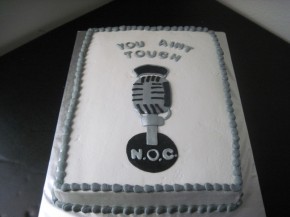
We ain't tough, but we sure is noisy.
Today marks the first anniversary of Noise Jockey’s very first post. Like any one year old, it can be annoying and loud but have moments of awesomeness that make it all worthwhile.
99.9% of those awesome moments have come from you, this site’s visitors. I’ve gotten back far more than I’ve given, which makes me humbled, honored, and much better informed than when I started.
Noise Jockey is simply the blog of a creative personality that’s driven to explore, share, and learn. I’ve found that its readers are exactly the same. You all amaze me with your own blogs, audio explorations, and even online sound communities…if you’ve not yet done so, check out each other’s online audio goodness in the sidebar.
Here’s to another great year of sonic wackiness, and I hope you’ll continue to join me.
| 9 Comments »
Posted: July 3rd, 2010 | Author: Nathan | Filed under: field recording, gear, nature recording
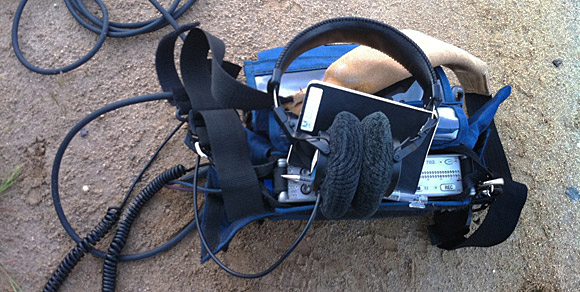
Neither dirt, nor fog, nor clouds of mosquitos keeps a field recordist from his crack-of-dawn tasks!
I’m finally unpacked and rested from the inspiring (and exhausting) 26th Annual Nature Sounds Society Field Workshop in California’s Sierra Nevada. Since my last post was a compilation of high-level personal experiences, I thought that I’d report back about what worked, or didn’t work, in the field on the technology side of things…as well as share a recording from our first early-morning field session.
- Outdoor Gear. My REI trail stool was instrumental in keeping my body still (I can be a fidgety so-and-so), the importance of which can’t be understated when your preamp gain is at 80% of maximum and you can hear birds’ wing flaps 20 meters away. [Hint: For nature recording, more layers of softer materials – like fleece, soft-handed polyester, and wool - are the best for staying warm and silent. Consider gaffer-taping your metal zippers, too!]
- Microphones. My primary MKH 50/30 rig performed brilliantly, with a strong signal-to-noise ratio even in the quietest moments. I also got a chance to try out a rather large parabolic microphone…more on that in a later post. [Hint: If you want a mic for nature recording, you need to be looking in the <-16dBA self-noise range, the lower the better.]
- Recorders. The ol’ 702 worked its usual wonders. I monitored as mid-side in the field, only converting to left/right once I returned. A +8dB side signal using Tom Erbe’s +Matrix plug-in made for a wide, enveloping sense of space without losing center imaging. Â [Hint: Batteries drain faster when cold. Store spares inside your jacket, or in your sleeping bag with you overnight!]
The gear list across everyone was pretty insane: many Olympus LS10 recorders, several Sound Devices 744T’s, a Sony PCM-D50, and mics from DPA, Neumann, Røde, Sennheiser, and Telinga. Recording techniques varied from mono to mid-side stereo, XY stereo, ORTF, Jecklin discs, and even two binaural dummy-head rigs (see this site for a good explanation of all this alphabet soup). An outdoor mic directionality seminar helped to illustrate what each is good for, which was a rare opportunity and extremely educational.
Yeah, yeah, whatever. But what did it sound like?
Today’s sound was recorded around 5:45am on a day with a slight breeze and scads of ground fog. The location was Sierra Valley, north of state route 49 in the Sierra Nevada. This recording includes at least swallows (cave or barn, I’m unsure), American bitterns, red-winged blackbirds, white-faced ibises, yellow-faced blackbirds, and a bullfrog, and certainly more that I can’t identify.
Get those headphones on and close your eyes…
[soundcloud url=”http://soundcloud.com/noisejockey/amb-bird-dawnchorus-sierravalley-01″ params=”show_comments=true&auto_play=false&color=dd0000″ width=”100%” height=”81″ ]
[Sennheiser MKH 50 and MKH 30 recorded as mid-side pair into Sound Devices 702 recorder]
Tags: audio equipment, birds, birdsong, camping, digital audio, field recording, microphone, nature, nature recording, Sierra Nevada, sound design, sound effects | 5 Comments »
Posted: July 1st, 2010 | Author: Nathan | Filed under: field recording, nature recording, news, video/motion
[Sound Design] Field Recording Workshop 2010 from Noise Jockey on Vimeo.
I’m just back from the 26th Annual Nature Sounds Society Field Workshop. I thought that I’d share some video diary entries that I shot with my new iPhone 4. As far as I know, this is the first time that video of this workshop has ever been seen online.
I’ll be sharing more of the learnings, experiences, and recordings in the coming weeks. For now, I hope you enjoy this set of dispatches from the field.
[You can read about the gear I took with me in a previous post.]
Tags: animals, audio equipment, birds, birdsong, digital audio, field recording, microphone, nature, nature recording, nature sounds, Sierra Nevada, sound effects, travel | 8 Comments »






